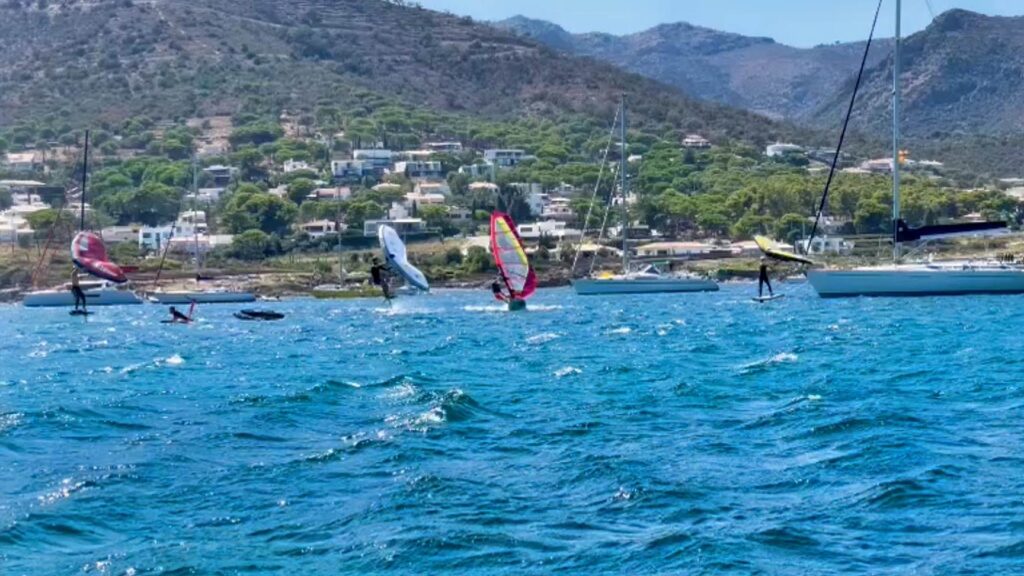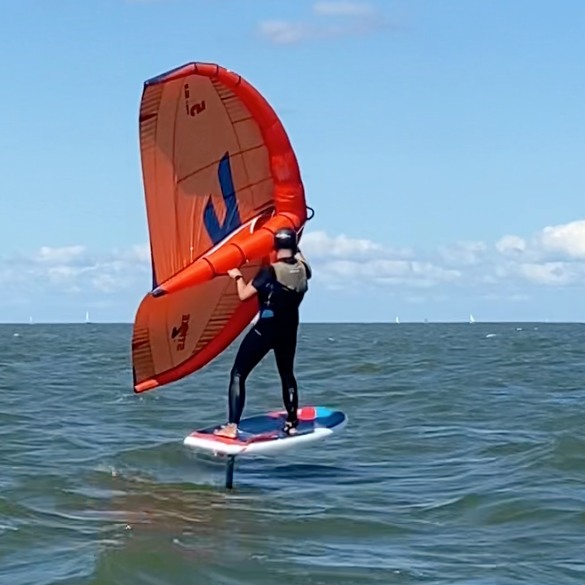Windsurfing has long been a beloved water sport, allowing enthusiasts to harness the power of the wind and glide gracefully across the water’s surface. However, in recent years, a new kid on the block has emerged, offering a fresh take on wind-powered water sports: wingfoiling. If you’re a seasoned windsurfer considering a switch to wingfoiling, here’s what you can expect from this thrilling transition.
What you need to know about switching from windsurf to wingfoil
The transition from windsurfing to wingfoiling is an exciting journey filled with new challenges and incredible sensations. While there are differences to navigate, the thrill of flight, versatility, and sense of adventure make it a transition that many windsurfers find deeply rewarding. If you embrace the learning process, enjoy the ride, and discover the joys of wingfoiling, you soar to new heights on the water.
These are the most important elements of the transition.

Learning the wing
The most significant difference between windsurfing and wingfoiling lies in the equipment. Instead of a windsurfing board and sail, you’ll be working with a wing – a handheld sail-like apparatus. Learning to handle the wing effectively is your first challenge. Unlike the fixed rig of a windsurfing sail, the wing is dynamic, requiring you to control its shape and angle to harness the wind’s power. Read more about learning to handle the wing.

Mastering the balance: difference between windsurf and wingfoil
While windsurfing relies on the board for stability, wingfoiling requires you to balance on a foilboard – a more specialized and often narrower platform. Finding your balance on the foilboard, especially when getting on the foil, can be tricky at first. But don’t worry; it becomes second nature with practice.

One of the biggest adjustments windsurfers have to learn when switching from windsurf to wingfoil, is to not hang backwards when speeding up.
If you do this, you will fall backwards. It can take various sessions to stay in the middle of the board when speeding up.
Once you learn to speed up and stay centred on the board, your board will start to plane and get on the foil.
As a windsurfer, you only need to feel this experience 2 or 3 times and your muscle memory will get the message.
The flying has begun!

Flight sensation
One of the most exhilarating aspects of wingfoiling is the sensation of flight. Once you’ve mastered the wing and found your balance, you’ll experience the incredible feeling of lifting off the water and gliding above it. It’s like soaring over the surface, and it’s an experience unique to wingfoiling.
Beginner wingfoilers fly at a speed of 18-22 kilometers per hour. This is slower than most windsurfers, but the fact that you fly above the water brings a real kick. Adanced riders can cruise at 30-45 kilometers per hour and pros can reach over 55 kilometers per hour.
See more about wingfoil: learning how to fly.

Wind conditions: wingfoil vs. windsurf
Windsurfers are accustomed to relying on consistent winds to keep their sails filled. In wingfoiling, you can ride in lighter winds, thanks to the wing’s efficiency. Another big factor is the fact that, as soon as you fly, your equipment suffers hardly any resistance from the water anymore. Therefore, it takes a lot less power to keep on flying.
If you have a good set of equipment and you master the wingfoil pumping technique, with a gust of 14 knots you are on the foil. With 11-12 knots you can keep flight over a longer distance. This opens up opportunities to wingfoil in conditions that might not be ideal for windsurfing, providing more time on the water.
On the other hand, the wing is easy to trim for light and heavy wind conditions. You trim it by lifting the wing higher above your head in strong winds, and lower (in a more vertical position) in lighter winds. This allows you to use one wing in a wind range that varies 10 knots easily.
Versatility and exploration
Wingfoiling offers versatility that windsurfing can’t match. You can wingfoil in a variety of conditions, from flatwater lagoons to open ocean swells. This versatility encourages exploration, as you can seek out different spots and adapt to the conditions on the fly.
Another cool element about wingfoiling is that your angle of attack is a lot bigger in wingfoiling. You can really go upwind a lot easier and further, as well as cruising downwind. This allows for wingfoilers to make exciting trips in many more direction than what windsurfers do.
Exploring different spots
Since wingfoil equipment is a lto easier to transport than windsurf equipment, a lot of riders find themselves surfing on many different locations. You can easily fit a wingfoil set with two wings in a mid-sized car, especially if you have an inflatable board. That allows you to drop your equipment in your car, drive a couple of hours and have a great session at a different spot. Learn more about wingfoil travel tips or discover different wingfoil spots.
In example: If you live in Barcelona, you are not limited to your home spot. You actually see wingfoilers from Barcelona driving 2 hours up to Leucate in France for a strong wind session as well as driving down south towards the great wingfoil spot of El Trabucador, 2 hours south of Barcelona. This makes your wingfoil experience so much more exciting!

Community and cameraderie
Just like windsurfing, wingfoiling has a passionate and growing community of enthusiasts. You’ll find camaraderie and shared experiences with fellow wingfoilers, making it a welcoming and social sport.
Switching from windsurfing to wingfoiling offers a new and exhilarating experience on the water. While there are learning curves, the transition is manageable, and many find the rewards of wingfoiling well worth the effort.
Finally, remember that mastering wingfoiling takes time and patience. It’s a new skill set with its learning curve, but the reward of gliding gracefully above the water is well worth the effort.
Switching from windsurf to wingfoil: FAQ
Wingfoiling is a water sport that involves riding a foilboard with a handheld wing. Unlike windsurfing, which uses a sail attached to a mast, wingfoiling uses a dynamic wing that you hold in your hands to harness the wind’s power. The key difference is the equipment and the sensation of flight.
While prior windsurfing experience can be beneficial, it’s not a strict requirement. Many wingfoilers come from various water sports backgrounds or start as complete beginners. Learning to handle the wing and foilboard is essential, and previous board sports experience can be helpful.
Balance and water awareness skills developed in windsurfing can be advantageous when transitioning to wingfoiling. Additionally, understanding wind principles and reading weather conditions are skills that carry over.
Learning to handle the wing effectively and finding your balance on a foilboard are the primary challenges. The sensation of flight and foil control can take some time to master, but with practice, these challenges can be overcome.
Wingfoiling typically requires a specialized foilboard designed for the sport. While it’s possible to adapt a windsurfing board for wingfoiling, it’s recommended to invest in a dedicated foilboard for the best experience.
Wingfoiling can be enjoyed in lighter winds compared to windsurfing. The wing’s efficiency allows for riding in a broader range of wind conditions, making it possible to wingfoil when windsurfing might not be practical.
The time it takes to become proficient in wingfoiling varies depending on individual skills and experience. Some windsurfers adapt quickly due to their water sports background, while others may take more time. Consistent practice and lessons from experienced wingfoilers can expedite the learning process.
